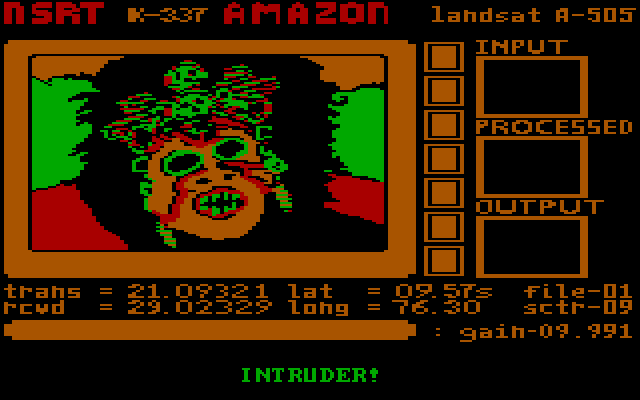When Michael Crichton Co-Wrote His Own Video Game
Jurassic Park writer Michael Crichton wrote a game? Based on his own novel Congo? Yep, it's true...
For many, Michael Crichton will always be remembered as the author behind one of the biggest film franchises of all time: Jurassic Park. But as well as writing popular novels and non-fiction books, directing his own hit movies (such as the classic Westworld), Crichton also dabbled in the realm of video games.
It was in the late 1970s, when Crichton replaced his old Olivetti word processor with an Apple II, that his fascination with computers began, and he started to learn how to program in BASIC. His enthusiasm was such that he regularly contributed to Creative Computing magazine, and even wrote a non-fiction book, Electronic Life, which aimed to introduce technophobic readers to the brave new world of computers.
All of this led to one of Crichton’s lesser-known creative forays: in 1984, he co-wrote an adventure game called Amazon.
Amazon is a graphic adventure that is fairly typical of its era. It tells a story through a mixture of text and images, and the player forges a path through the narrative by typing in simple commands like “go north,” “examine cupboard,” and “open door.” Crichton originally wanted to base the game on Congo, the sci-fi adventure novel he’d written four years earlier. But when it emerged that Crichton had unwittingly sold the rights to a Hollywood studio, he was left in the unfortunate position of being unable to create a game based on his own book.
As a result, Crichton set about changing some of the story elements in Congo – its location, as you’ve probably guessed, was switched from Zaire to the Amazon, and talking ape became a voluble parrot – while keeping the same basic plot. The game sees an expedition to the Amazon go unexpectedly awry, with all members of the party killed in mysterious circumstances. The player, cast as an intrepid explorer, is dispatched to find out what happened and encounters “vicious Huni warriors,” machine gun-toting soldiers, and a place called The Lost City of Chak.
Crichton teamed up with programmer Stephen Warady and artist David Durand to make Amazon, but Crichton actually programmed certain sections of the game himself. According to a 1985 issue of Creative Computing, Crichton wrote “the graphics routines for the main titles, modules that deal with turning the computer (in the game) on, and all the sound effects.” That’s pretty impressive for someone who said of his programming ability, “I don’t do that very well.”
Crichton’s interest in making his own game was borne partly out of his desire to improve on the text adventures he’d already played. As Crichton pointed out in another interview from the mid-80s, uncovered by writer Jimmy Maher, that many game designers at the time were more adept at programming than telling a satisfying story:
“If I play a game for a half-hour and it doesn’t make any sense to me, I’ll just quit and never go back,” Crichton said. “Say I’m locked in this house and I don’t know what the point of the house is and why I can’t get out and there’s no sort of hint to me about the mentality that would assist me in getting out – I don’t know. I could say ‘Shazam!’ or I could burn the house down or – give me a break. I just stop.”
Looking back at Amazon, it’s easy to see how Crichton applied his talent as a writer and filmmaker to a relatively new medium. An opening sequence, in which the static on a monitor clears to reveal a devastated camp in the Amazon, strewn with dead bodies, has a cinematic quality that was still quite rare among graphic adventures of the time. And while the player’s choice of paths through the game is limited at times, Amazon does a good job of placing you in the middle of a rip-roaring thriller. There are villains and mysteries and an exploding volcano, and true to form, Crichton even throws in a high-tech gadget or two.

While Amazon‘s a relatively obscure game these days, it was a decent hit at the time of its release. Programmed first for the Apple II and then ported to the Commodore 64 and other computers of the day, it reportedly sold around 100,000 copies – a healthy number for the time. Amazon was also the first game from Trillium (quickly renamed Telarium), a company which specialized in making adventure games in collaboration with popular authors. Some of its most significant titles included Ray Bradbury’s Fahrenheit 451 and Arthur C. Clarke’s Rendezvous with Rama, both adapted from their novels and made with the writers’ input.
Amazon wasn’t Crichton’s only foray into the world of video games, either. In 1999, he set up a company called Timeline Computer Entertainment. Its first game was Timeline, a 3D adventure based on Crichton’s novel of the same name. Regrettably, Timeline wasn’t as well received as Amazon, and the company behind it folded shortly after the game’s release.
While his novels were often cautionary tales about future technology and meddling with nature, Crichton clearly had an affection for computers. Among the authors of his generation, Crichton was one of the first to truly understand the storytelling possibilities of games. At a time when many writers and filmmakers were still getting to grips with how a computer worked, he recognized that this new medium could be as valid a means of storytelling as a movie or a novel. As Crichton once put it, “My interest is trying to tell a story in a new way.”